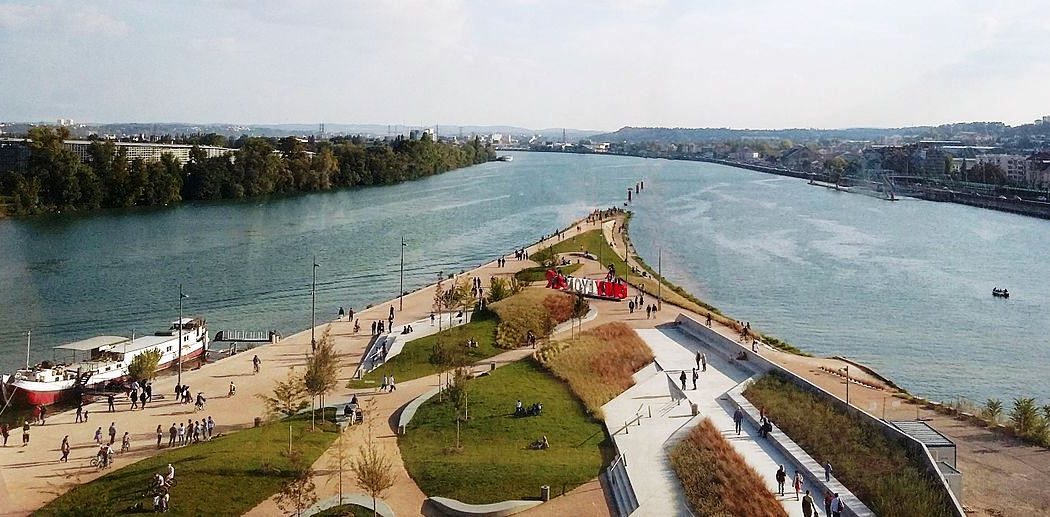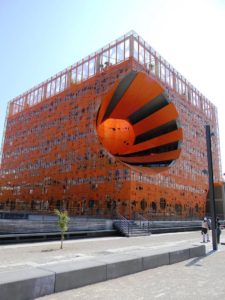Lyon is the capital of the Auvergne-Rhône-Alpes region of France. Much of its recent history has been as an industrial center, and it’s often referred to as the Chicago of France.
Like Chicago, it has many grand old buildings (though Lyon’s are far older, of course), and like Chicago, they are working hard to revitalize the abandoned, contaminated, post-industrial area of the city.
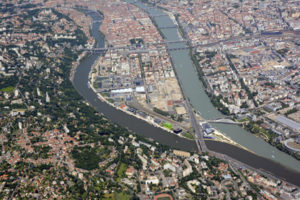 The La Confluence port neighborhood of Lyon was one of those hearts of heavy industry, but a new visitor would hardly be able to guess that these days. A vast 373-acre site at the confluence of the Saone and Rhone rivers in the center of Lyon, has been transformed structurally, functionally, ecologically and economically.
The La Confluence port neighborhood of Lyon was one of those hearts of heavy industry, but a new visitor would hardly be able to guess that these days. A vast 373-acre site at the confluence of the Saone and Rhone rivers in the center of Lyon, has been transformed structurally, functionally, ecologically and economically.
Today, La Confluence is possibly the most dynamic and liveliest parts of the city. It’s a major tourist draw, and functions unlike any other part of Lyon.
Made up of former docklands, the neighborhood has been thoroughly revitalized, thanks to an ongoing urban redevelopment project. That project is focused on creating a sustainable, walkable, and diverse neighborhood featuring green infrastructure, networks of parks, and self-driven shuttles.
Affordable housing has been a revitalizing force, as well. As of 2015, of the 1500 newly-built apartments in La Confluence, 40% are designated as affordable. It also contains some of France’s most eye-catching modern architecture, breaking with the grand old building traditions of the city.
But it’s not just about buildings: La Confluence boasts some of the city’s best nightlife, thanks to old warehouses repurposed as performance spaces, which are now attract international artists.
Local government officials say that La Confluence’s redevelopment has a single objective: to rebuild a smart and sustainable city. The challenge is balancing environmental requirements with the anticipated needs of future users.
They ruled out a purely technical and regulatory approach, deciding instead to make quality of life the priority. Ever since the regeneration was launched, they have sought to create a simple, innovative and creative city by encouraging human-powered transport and limiting negative environmental impacts.
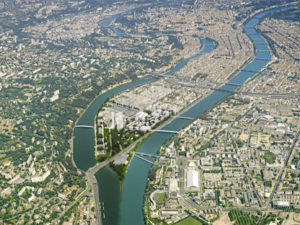 Making the city accessible to all means reconnecting all existing and new structures, and surrounding neighborhoods.
Making the city accessible to all means reconnecting all existing and new structures, and surrounding neighborhoods.
This makes La Confluence a good example of the 3Re Strategy (repurpose, renew, reconnect): they have repurposed an old industrial area as a mixed-use community; they have renewed the area by cleaning the contamination and renovating the reusable buildings; and they have reconnected the area both internally and externally.
It’s not just the easy-to-repurpose warehouses that are being adaptively reused, either. Many of the corporate office building and factories are being renovated and redesigned also. Examples include the headquarters of the CRCI (Regional Chamber of Commerce & Industry); the housing program called Le Patio; an office block called Empreinte; a building called La Cure opposite the church; a community services program called Quai 19 on the Perrache quay; and the headquarters of Candia Milky Way which has been subject to an ambitious green renovation.
The city says they have made the following commitments to the rebirth of La Confluence:
- To implement a mixed and varied set of construction programmes (social and functional diversity);
- To enhance the Saone and Rhone rivers and the quality of their landscapes;
- To create an extensive green infrastructure and a network of parks;
- To develop public transport and a walkable city;
- To ensure high quality urban blending with the existing Perrache – Sainte-Blandine neighborhood;
- To increase the number of connections with the surrounding urban neighbourhoods (Lyon’s Gerland, Presqu’île, and 5th district);
- To encourage environmental and architectural technical innovation;
- To transform the motorway into a peaceful urban boulevard.
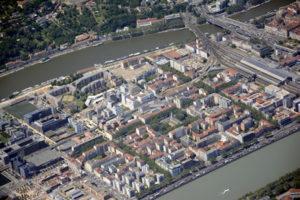 Phase 1 is a mixed-use redevelopment of the Saone Embankments along the Saone River. Phase 2 is a mixed-use redevelopment of the Perrache – Sainte Blandine area along the Rhone River. The Perrache district is part of the Sainte Blandine neighborhood, and is renowned for both its rail station and its old prisons. The area was long seen as an obstacle, separating the two halves of the city center peninsula in La Confluence.
Phase 1 is a mixed-use redevelopment of the Saone Embankments along the Saone River. Phase 2 is a mixed-use redevelopment of the Perrache – Sainte Blandine area along the Rhone River. The Perrache district is part of the Sainte Blandine neighborhood, and is renowned for both its rail station and its old prisons. The area was long seen as an obstacle, separating the two halves of the city center peninsula in La Confluence.
It is now being redesigned to reconnect the heart of the city and serve as an urban nexus. The two drivers behind the change are the multi-modal transport station, which is currently undergoing transformation, and the Université Catholique de Lyon, which opened in 2015.
Featured photo by Prométhée (via Wikipedia) is of a new public park at the confluence of the Rhône and Saône Rivers. Aerial photos are courtesy of the City of Lyon.

